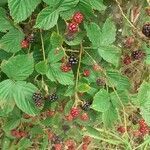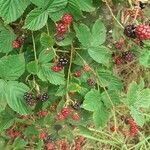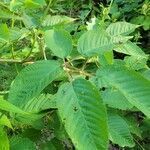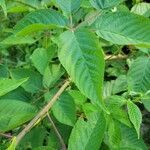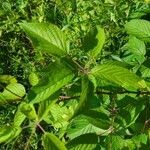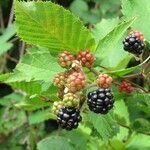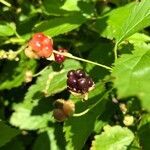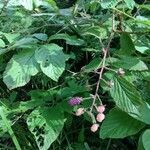Shrubs, 5–30 dm, unarmed or armed. Stems ?biennial?, arching, glabrous, eglandular or sparsely sessile-to short-stipitate-glandular, not pruinose; prickles absent or sparse, erect or slightly retrorse, slender, 2–5 mm, narrow-to broad-based. Leaves deciduous, usually palmately compound, ?lustrous?; stipules filiform to narrowly lanceolate, (5–)8–15(–22) mm; leaflets (3–)5, terminal ovate to elliptic, (3–)7–9(–11) × (3–)4–5(–6) cm, base rounded to shallowly cordate, unlobed, margins finely to coarsely serrate or doubly serrate, apex acuminate to attenuate, abaxial surfaces sometimes with hooked prickles on midvein, glabrous or puberulent, eglandular. Inflorescences terminal ?on short shoots, sometimes appearing axillary?, (5–)15–25-flowered, racemiform. Pedicels usually unarmed, hairy, eglandular or sparsely sessile-to short-stipitate-glandular. Flowers bisexual; petals white, obovate to elliptic, 8–22 mm; filaments filiform; ovaries glabrous. Fruits black, globose to short-cylindric, 1–2 cm; drupelets 10–75, strongly coherent, separating with torus attached. 2n = 14, 21.
More
Much like R. pensilvanicus, which might perhaps better be merged with it, but usually only sparsely armed, with few, small, and weak prickles, and with glabrous or subglabrous lvs. Often in open deciduous forest or on mt. ledges, as well as in disturbed habitats; Nf. and Que. to Minn., s. through N.Y. and along the mts. to n. Ga. June, July. (R. amicalis; R. kennedyanus; R. multilicius)
A bramble. It is a trailing plant. The fruit can be 2 cm across.
Thickets, woods and clearings. Mountainous highlands, cool, shaded intermediate regions within deciduous and boreal forests, margins of lakes and woods; at elevations up to 2,000 metres.
More
It is a temperate plant. It can tolerate frost.
Can be grown by cuttings or seedlings. Seeds needs stratification.
